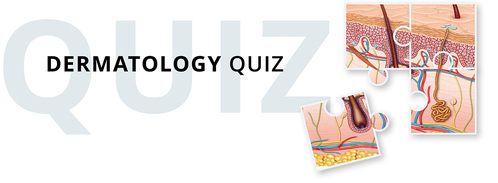What’s the diagnosis?
A painful violaceous lesion on the thigh

Case history
A 48-year-old woman presents with a painful violaceous lesion on her thigh (Figure). Three days previously she had commenced warfarin after developing a deep vein thrombosis. Her INR is in the therapeutic range.
Diagnosis
The patient was diagnosed with coumarin (warfarin) necrosis. Patients are systemically well and usually present with sudden onset of pain followed by well-demarcated erythema that progresses to haemorrhagic necrosis, sometimes with blistering, within three to five days of commencing warfarin therapy. It is most often seen in body areas with abundant subcutaneous fat, such as the hip, breast, buttock and thigh.
This is a very uncommon condition, occurring in less than 0.1% of warfarin-treated patients, but the appearance of a lesion of this nature shortly after commencing warfarin is characteristic. It is much more common in women than men.1
Differential diagnosis
Coumarin necrosis is a spot diagnosis, supported by a history of recent commencement of warfarin. Conditions to consider in the differential diagnosis include the following.
- Necrotising fasciitis. A patient would be very unwell and febrile in this setting, with a high antistreptolysin O titre and white cell count.
- Insect bite reaction. It is most unlikely that a patient would not recall being bitten by a wasp or spider to cause a severe reaction of this nature.
- Pyoderma gangrenosum. This is primarily an ulcerative rather than a thrombotic condition.
Pathogenesis
When warfarin is initiated, protein C and factor VII are more strongly inhibited than the other vitamin K-dependent coagulation factors (II, IX and X). This imbalance may result in a hypercoagulable state, leading to thrombosis and then ischaemic necrosis. The higher the initial dose of warfarin, the more marked the difference. The INR may be in the therapeutic range in these patients because it depends on factor VII.
About one-third of patients who develop coumarin necrosis have a deficiency of protein C, which predisposes them to this condition. Deficiencies in factor S, factor V Leiden and antithrombin III have also been observed in affected individuals.
Management
For patients who develop coumarin necrosis, warfarin therapy should be ceased and a haematologist’s opinion obtained. Patients often commence heparin therapy because of the hypercoagulable state responsible for the necrosis. There have been reports of patients continuing warfarin without necrosis progression.2 Newer anticoagulants such as dabigatran etexilate have been used to prevent coumarin necrosis in patients who are known to have a protein C deficiency. Local care to the ischaemic area may involve debridement, but milder cases resolve spontaneously.
Deep vein thrombosis

